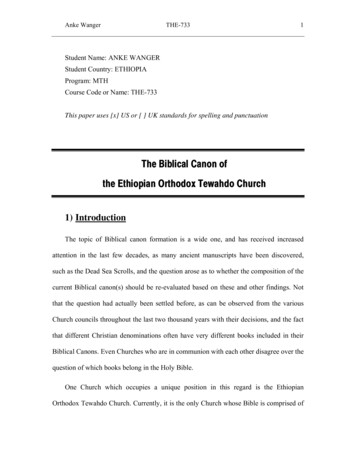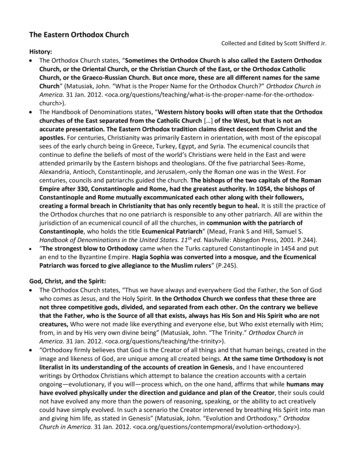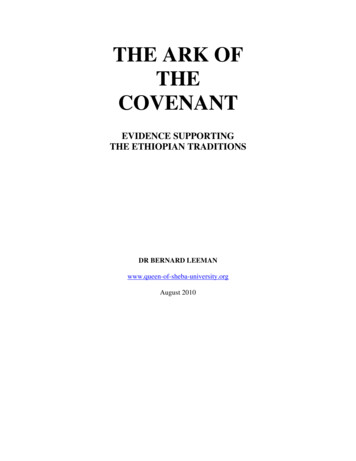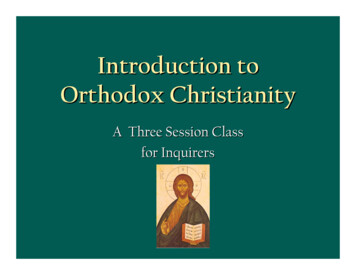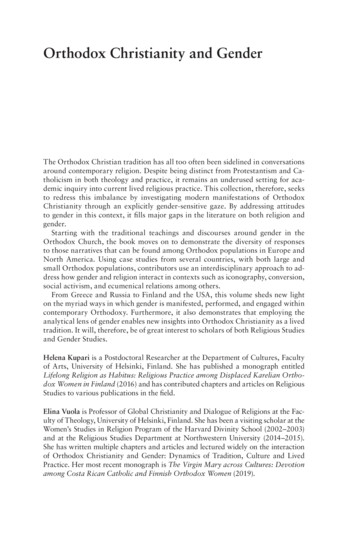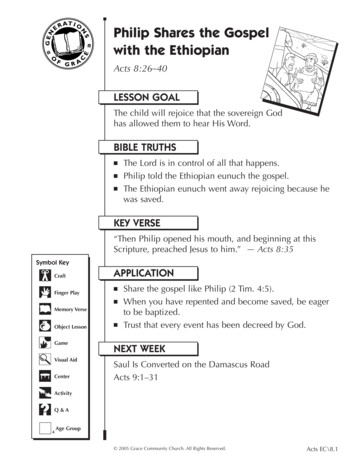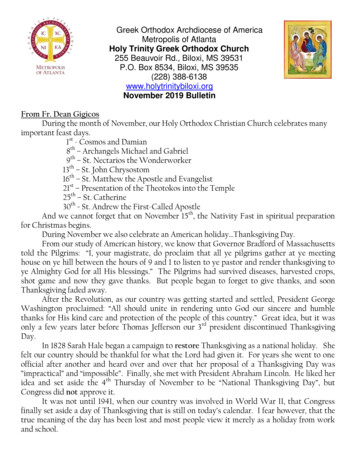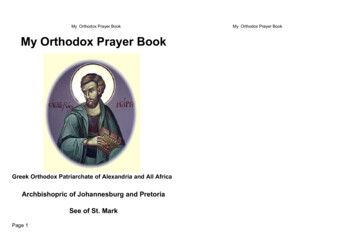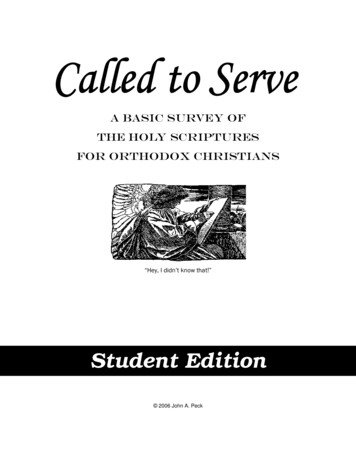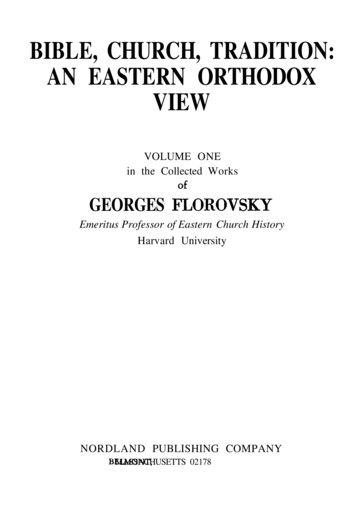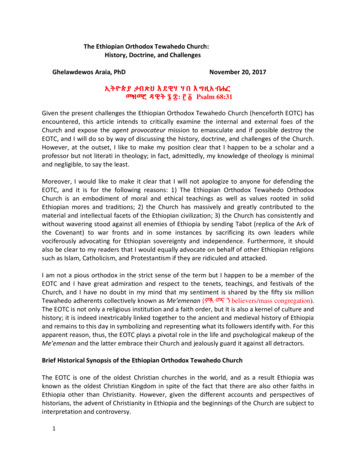
Transcription
The Ethiopian Orthodox Tewahedo Church:History, Doctrine, and ChallengesGhelawdewos Araia, PhDNovember 20, 2017ኢትዮጵያ ታበጽህ እ ደዊሃ ሃ በ እ ግዚአ ብሔርመዝሙር ዳዊት ፮ ፰: ፫ ፩ Psalm 68:31Given the present challenges the Ethiopian Orthodox Tewahedo Church (henceforth EOTC) hasencountered, this article intends to critically examine the internal and external foes of theChurch and expose the agent provocateur mission to emasculate and if possible destroy theEOTC, and I will do so by way of discussing the history, doctrine, and challenges of the Church.However, at the outset, I like to make my position clear that I happen to be a scholar and aprofessor but not literati in theology; in fact, admittedly, my knowledge of theology is minimaland negligible, to say the least.Moreover, I would like to make it clear that I will not apologize to anyone for defending theEOTC, and it is for the following reasons: 1) The Ethiopian Orthodox Tewahedo OrthodoxChurch is an embodiment of moral and ethical teachings as well as values rooted in solidEthiopian mores and traditions; 2) the Church has massively and greatly contributed to thematerial and intellectual facets of the Ethiopian civilization; 3) the Church has consistently andwithout wavering stood against all enemies of Ethiopia by sending Tabot (replica of the Ark ofthe Covenant) to war fronts and in some instances by sacrificing its own leaders whilevociferously advocating for Ethiopian sovereignty and independence. Furthermore, it shouldalso be clear to my readers that I would equally advocate on behalf of other Ethiopian religionssuch as Islam, Catholicism, and Protestantism if they are ridiculed and attacked.I am not a pious orthodox in the strict sense of the term but I happen to be a member of theEOTC and I have great admiration and respect to the tenets, teachings, and festivals of theChurch, and I have no doubt in my mind that my sentiment is shared by the fifty six millionTewahedo adherents collectively known as Me’emenan (ምእ መና ን believers/mass congregation).The EOTC is not only a religious institution and a faith order, but it is also a kernel of culture andhistory; it is indeed inextricably linked together to the ancient and medieval history of Ethiopiaand remains to this day in symbolizing and representing what its followers identify with. For thisapparent reason, thus, the EOTC plays a pivotal role in the life and psychological makeup of theMe’emenan and the latter embrace their Church and jealously guard it against all detractors.Brief Historical Synopsis of the Ethiopian Orthodox Tewahedo ChurchThe EOTC is one of the oldest Christian churches in the world, and as a result Ethiopia wasknown as the oldest Christian Kingdom in spite of the fact that there are also other faiths inEthiopia other than Christianity. However, given the different accounts and perspectives ofhistorians, the advent of Christianity in Ethiopia and the beginnings of the Church are subject tointerpretation and controversy.1
Most Ethiopians in the 1960s, 1970s, 1980s, and beyond have taken it for granted, and I mightadd without being critical, that Christianity in Ethiopia was anchored following Ezana, the firstChristian king, in the first half of the 4th century. Some historians have a slightly different viewand attribute the coming of Christianity to Ethiopia to one Ethiopian eunuch, a treasurer forQueen Hendake (aka Gersamot and/or Candace), while sojourning in Jerusalem met Philip theEvangelist (not the Apostle) and he was subsequently baptized by him. Thus, the argumentcontinues, the treasurer of Queen Hendake was the first Christian convert, and after hereturned to his homeland Ethiopia, he, in turn, undertook the mission of converting otherEthiopians to Christianity.One other version of the history of Christianity in Ethiopia is also associated with St. Matthew,one of the twelve Apostles, or one of the four Evangelists according to Christian tradition,preached in Ethiopia and died in Ethiopia in 74 Common Era (CE) and it is highly probable thatSt. Matthew baptized a significant number of Ethiopians before he died. Now, if we puttogether the story of the treasurer of Queen Hendake and that of St. Matthew’s preaching inEthiopia, there is only a distance of two decades between the Queen’s end of her reign (50 or52 CE) and the death of the Evangelist. In the first two decades of the first century CE, thus,some Christian sects had established themselves in present-day Tigray Regional State ofEthiopia, and it seems to me that this argument is more convincing, viable, and plausible.Therefore, depending on plausible historical accounts and logical inferences, we can withconfidence assert that there were Christians in Ethiopia three centuries before Ezana becameChristian. There is no doubt that that Emperor Ezana (320-360) was the first Christian king ofEthiopia but we don’t have any credible evidence that mass baptism followed the king’sconversion to Christianity, but there is no doubt that those Christian Ethiopians, who for themost part conducted their prayers underground, now came out to the public square withoutfear and intimidation. This was a great historical event in Ethiopian history because after Ezanaembraced Christianity, the latter faith became official religion of Ethiopia and the first Ethiopianchurch was established and for the last one thousand and seven hundred years, the Churchoccupied a center stage position in the annals of Ethiopian history.On top of the above backdrop on the advent of Christianity in Ethiopia, it is important toacknowledge the harbingers of official Christianity and the establishment of the incipientEthiopian church. According to legend and some documentary evidence, two young brothers bythe name Frumentius and Aedasius, whose ship wrecked on the Red Sea, were brought to thecourt of Ezana, and later the elder Frumentius (known as Freminatos in Ethiopia) became thefirst bishop of the first Ethiopian church in Askum after he was consecrated by Pope Athanasiusin 328 CE. Apparently, Athanasius was the protagonist who argued against Arius at the Councilof Nicaea in 325 CE; only three years after Nicaea, thus, the new Ethiopian Christian TewahedoChurch was founded as followers of Athanasius and ever since the Church was headed by anEgyptian bishop until it became autocephalous.2
The EOTC further consolidated after the Council of Chalcedon in 451 CE and the coming of thenine saints to Ethiopia around 480 CE. Most of these saints came from Syria and otherneighboring countries then ruled by the Byzantine Roman Empire of late antiquity; in some oralhistory and narrative with respect to the saints they are often confused as Romans due toRoman hegemony but most of them are of Western Asia or what we call today ‘middle eastern’origins; they were anti-Chalcedon and they were persecuted by the powers-that-be of theRoman Empire, fled their respective countries and found sanctuary in Ethiopia. Indeed, theywere well received by the Christian king Kaleb (Ella Atsbeha) and soon after they began toacclimatize the Ethiopian environment; they began learning Geez and studying the local cultureas well as finding monasteries as shown below:Name of SaintPlace of MonasteryAbba PentelewonAksumAbba LiqanosAksumAbba Aregawi (aka Ze-Michael)Debre DamoAbba AfseYehaAbba GubaMudamaAbba Gerima (aka Ishaq)AdwaAbba TsehmaSedenyaAbba Yam’ataGere’altaAbba AlefBi’isa (at Mereb River)Copyright Institute of Development and Education for Africa (IDEA) 2017All nine saints were followers of St. Pachomius (292-348 CE) who pioneered Christian cenobitemonasticism, the gregarious community life of monks as opposed to solitary hermitage. St.Pachomius (aka St. Pachome) was very much revered by the Eastern and Oriental OrthodoxChurches as well as the Catholic Church; and he is known as ‘the renewer’ or re-creator by theLutheran Church.All nine saints have greatly contributed to the enhancement of the EOTC doctrine and inbaptizing and educating the Ethiopian people, but among these saints, it is Abba Aregawi whostands out in terms of expanding evangelism and the scholastic domain of the early EthiopianChurch; it is with his encouragement that the first schools of the EOTC emerged and ultimatelyproduced giant theologians and learned men like Yared (later canonized as St. Yared), who iscredited for composing musical notations for the first time ever (see Yared’s musical notationsin Appendix 1).Ultimately the EOTC became an autocephalous church by the agreement reached with theEgyptian Coptic Church in 1948 but the road of independence for the EOTC was paved byEmperor Haile Selassie when he founded the Theology College of the Holy Trinity Church in1944. In 1951, an Ethiopian archbishop by the name Basilios was consecrated as head of theEthiopian Church and in eight years, he became the first Ethiopian patriarch of the EOTC. In1971, Abuna Theophilus succeeded Abuna Basilios but he was arrested by the military junta of3
Abuna Teklehaimanot to lead the Ethiopian Church but the ignorant and disgruntled Derggovernment officials were confronted by the Holy Synod, the top echelon of the Church. TheSynod of the EOTC, in no uncertain terms, told the Derg that it has not removed AbunaTheophilus and did not know of his whereabouts and hence would not accept AbunaTeklehaimanot as patriarch of Ethiopia.Although the Synod was firm in its decision against the Derg, it nonetheless confirmed (perhapsinadvertently) the appointment of the archbishop of Gondar, Abuna Merkorios, who at thetime was member of the Ethiopian Parliament (then known as Shengo)and who was closelyaffiliated to the military regime. Abuna Merkorios presided over the EOTC during the entireperiod of the Derg’s Red Terror without ever condemning the fascistic atrocities against theEthiopian people in which thousands upon thousands of Ethiopians were murdered. But in1991, after the Derg was toppled by the Ethiopian People’s Revolutionary Democratic Front(EPRDF), Abuna Merkorios was compelled to seek asylum and Bishop Paulos, who led theEthiopian Church at the Riverside Church in New York, became the Patriarch of the EthiopianChurch until his death in 2012. In February 2013, Abuna Mathias was confirmed as the sixthPatriarch of the EOTC since the latter gained its complete independence from the parent churchin Alexandria.The Ethiopian Orthodox Tewahedo Church is a highly organized religious institution and it isadministered by a complex hierarchy that, in turn, ordains priests, manages the day-to-dayroutine religious observations and services, and ensures the efficacy of Sunday sermons. Theleaders of the Church, as Stuart Munro-Hay puts it, “are persons who have acquired greatexperience in the church liturgy, songs, hymns, church calendar, and so on.” Moreover, MunroHay explains the differences in the structure of the hierarchy from place to place. “These titlesand functions of the hierarchy at Aksum are not universally applicable, there being some slightdifferences at, for example, Addis Ababa and Debre Berhan. In Addis Ababa, the officeequivalent of Afa nebura’ed is liqa tebebt, and that equivalent to qese gabaz is aleqa (theadministrator of a church). The megabi is entitled instead aggafari, which can be translated aschamberlain; he performs such tasks as supervising entry into a church, or preceding thedeacons and priests carrying the host of a dying man for absolution.”“To sum up, says Munro-Hay, the national church is headed by” [the]PatriarchLiqa papasPapasIn Aksum, the hierarchy is as follows:Nebura’ed(Choir)4(Ordained priestsAnd deacons in chargeOf church services)(Special officials)
Afa nebura’edQese gabazMere geta megabit Afa qese gebazLiqa mezemiranLiqa diyaqonatKegn geta gra geta MecheneMale’aka sahayDiyaqonMale’aka ghenetLiqa maimaran [memran/memhran]Liqa hiruanLiqa berhanatLiqa TiguhanRe’sa dabirMale’aka SibhatMale’aka selamMale’aka mihretMechene.1Kere geta kelebasLiqa kahenatDoctrine of the Ethiopian Orthodox Tewahedo Church (EOTC)The faith and teachings of the EOTC emanates from the Judea-Christian tradition by which theChurch accepted the Old Testament (generally referred to as Orit ኦ ሪ ት in Ethiopia) and theNew Testament, and the latter two books that make up the Ethiopian Bible, in fact, weretranslated from Greek into Geez during the reigns of Ezana and Kaleb respectively. Thecomplete Ethiopian Bible was thus in existence since the founding of the Ethiopian Church,although surprisingly a significant number of Ethiopians, including the congregation of theEOTC, don’t have knowledge about the Ethiopian Bible which consists 81 books as opposed tothe Protestant Bible that comprises 66 books.In due course of its early evolution, the EOTC, following the Council of Nicaea (325 CE) and theCouncil of Chalcedon (October 8 to November 1, 451 CE), polished its doctrine and dogma that Ilike to briefly address here. It is in the latter council that the real schism in the Christian religionoccurred; subsequently, the Ethiopians, Egyptians, Syrians, Armenians, and Indians (OrientalOrthodox group) began to identify themselves with the belief that Christ’s nature is “oneincarnate nature of God the word” as opposed to the “two natures of Christ” doctrine held bythe other Christian groups in the Chalcedon conference. The two groups were unable toreconcile their differences and they had gone separate ways. After the split the orientalorthodox group were labeled as monophysite to mean “one nature of Christ” in its superficialsense but the cynical attribute of the concept to the non-Chalcedon group was meant to conveythe neglect or lack of recognition of the two aspects (human and divine) in Christ, when in fact,on the contrary, the Oriental group did recognize the humanity and divinity of Christ but theystrongly argued that the two aspects were united and once they become one, they wereinseparable and as such they must be defined as one indivisible whole.5
In order to avoid misconception and confusion on the so-called monophysite, thus, theEthiopian Church along with its sister churches maintained that “mia” as opposed to “mono”stands for a composite unity and not simply as elemental unity as attested by the Council.Moreover, in order to clearly define the differences between ‘monophysis’ and ‘miaphysis’, theEthiopian Church called itself Tewahedo (ተዋህ ዶ), a term meaning “made one” and “which isthe best expression conveying the faith of the Church, since it emphasizes the inseparable unityof the Godhead and manhood in the person of Christ.”2In the above doctrinal argument, the word “inseparable” is important, because in terms ofdepicting the nature of Christ the Chalcedon and non-Chalcedon groups may sound speakingthe same language when they underscore the divinity and manhood of Christ, but in the case ofthe Chalcedon group, it was obvious that they have treated the divinity and manhood of theson of God separately and inferred in their logical deduction that Christ had two natures, aspresent-day Catholics and Protestants preach in their sermons.To further elucidate the controversy on the nature of Christ and reinforce the position of theEOTC on this issue, it is imperative to cite Pope Shenoda’s well-articulated reasoning in somelength: “The Orthodox concept concerning the nature of Christ, he argues, is the fact that “TheLord Jesus Christ is God himself, the Incarnate Logos who took to himself a perfect manhood.His Divine nature is one with his human nature yet without mingling, confusion or alteration; acomplete hypostatic union As this union is permanent, nor divided nor separated we say in theliturgy that his Godhead never separated from his manhood for a single moment nor even for atwinkle of an eye The Divine nature (God the Word) was united with the human nature whichhe took of the Virgin Mary by action of the Holy Spirit. The Holy Spirit purified and sanctifiedthe Virgin’s womb so that the Child to whom she gave birth would inherit nothing of theoriginal sin; the flesh formed of her blood was united with the Only-Begotten son. This unitytook place from the first moment of the Holy Pregnancy in the Virgin’s womb. As a result of theunity of both natures – the Divine and the human – inside the Virgin’s womb, one nature wasformed out of both: ‘The one Nature of God the Incarnate Logos’ as St. Cyril called it.” 3(Emphasis in the original)The most important, powerful and logically sound argument promoted by the EOTC on thenature of Christ is as follows: “If you separate the natures after the union and say that Christ isin two natures, you will be confronted with serious problems. You should have to admit, forinstance, that Christ was crucified merely as a man and that therefore he did not redeem theworld, for God alone is to accomplish the world’s redemption. In brief, it is held that Christ, inacting acted as a united being, not separately as man or separately as God.” 4 While thisargument is solid and strong as I have already underscored, in my opinion it would have beenmuch more powerful had the non-Chalcedon group, including the EOTC, have also included thereasoning that Christ would have not resurrected after his death on the cross had his humanitywas separated from his divinity; it is the indivisibility of his divine and human nature thatenabled him to have risen from the dead. Thus far, I have not witnessed such a supportingthesis in the EOTC doctrine in general and its liturgy and teachings in particular.6
However, in an effort to make its position clear on its doctrine, the EOTC also clearly definessacraments and its differences with the Protestant Church: “The sacraments are not meresymbols and ‘signs of the new covenant’ (as some Protestants say), but according to theEthiopian Orthodox Tewahedo Church, ‘there is a real efficacy in the sacraments themselves,and that they truly bring invisible graces to the believers. There are seven sacraments: baptism,confirmation, penance, Holy Communion, unction of the sick, matrimony, and the holyorders.”4 The seven sacraments of the EOTC and other sister Orthodox churches, by and large,are also shared by the Catholic Church, but the Protestants observe only two sacraments,namely, baptism and Eucharist.Although the EOTC is part and parcel of the five oriental Orthodox churches mentioned aboveand also shares faith-related creed with other Eastern Orthodox churches, it is in many waysunique in terms of engagement in practical religious observations such as Festival of the TrueHoly Cross or Meskel (መስ ቀ ል ), Epiphany or Timket (ጥምቀ ት)5, and the multitude of fastingobservations, including Hudade (ሁዳ ዴ or ዓ ብይ ጾ ም), a total of 55 days in three separateperiods; Tsome Herkal (ጾ መ ህ ር ቃል ), eight days, commemorating an early Christian figure;Tsome Arb’a (ጾ መአ ር ባ ), forty days to Lent; and Tsome Himmamat (ጾ መሕማማት), seven-dayholy week. There are also other fasting days by which EOTC adherents cleanse themselvesspiritually (and by default maintain their body health), and they are the Fast of the Apostles orTsome Hawaria (ጾ መ ሃ ዋር ያ ), the Fast of Redemption or Tsome Dihnet (ጾ መ ድሕነ ት) onWednesdays (when Christ was charged) and on Fridays (when Christ was crucified); the fast ofthe Dormition, associated literally with the Falling Asleep of the Blessed Virgin and figurativelywith the Assumption of St. Mary; the forty-day fast before Christmas; the Fast of Nineveh (ጾ መነ ነ ዌ), which lasts for only three days; and Fast of Gahad of Timket (የ ጥምቀት ገ ሃ ድ), a fast onthe eve of epiphany.The above analysis is an abridged form of the doctrine and order of the EOTC, and it is notwithin the scope of this article to discuss the EOTC and its dogma in depth and at length. Withthe above notes, thus, I move on to the challenges the Ethiopian Church encountered and tosome proposed solutions that I will present at the very end of this study.Challenges of the Ethiopian Orthodox Tewahedo Church (EOTC)As indicated earlier, the EOTC is now faced with formidable challenges. These challenges arevery complex and require a craftily designed investigative discourse in order to correctlyidentify the problems and come up with the right solution. In my opinion, the challenges aremany and variegated, and although it may be difficult to diagnose the challenges within theChurch itself – from the Holy Synod to the bottom hierarchy of the administration of the EOTC –it is easy to analyze and discuss the relatively visible problems the Church faced presently.Before I delve into the parameters of the challenges, however, in an effort to reinforce mythesis with respect to the challenging foes of the EOTC, I like to quote a relevant paragraphfrom ማር ይስ ሐቅ (Mar Yishaq)6 religious guide book, as shown below,ግእ ዝ: ወተዓ ቀ ብ እ ምአ ን ብቦ ተ ዕ ል ወተሙለ ዕ ል ዋን7
አ ማር ኛ: የ መና ፍቃን መፅ ሐፍ ከ መመል ከ ት ተከ ል ከ ልግእ ዝ: ዑቅ ከ ምእ ቀ ር ብ ሃ ቤሃ :: እ ስ መ ዝን ቱ ግብር ውእ ቱ ዘ የ ስ ተና ሥኦ ላ ዕ ሌከ ፈድፋደእ ምግብር ለ መን ፈስ ፀ ሪ ፍአ ማር ኛ: ገ ል ፀ ህ አ ትይ:: ከ ሥራ በ ማና ቸውም ሥራ አ ን ድም የ መና ፍቃን መፅ ሐፍ ከ መመል ከ ትህየ ተነ ሣ:: አ ን ድም በ ግድ መን ፈስ ፀ ሪ ፍን የ ሚያ ነ ሳ ሳ ውይህ ሥራ ነ ውና ስ ነ ፍጥረ ት ነ ው::ግእ ዝ: ወእ ምከ መአ ፅ ገ ብከ ለ ነ ፍስ ከ እ ቲትሐን ቅቅአ ማር ኛ: (የ ነ ብያ ት የ ሐዋር ያ ትን መጽሐፍ ከ መመል ከ ትህ በ ኋ ላ ) የ መና ፋቅን መጽሐፍ በ መመል ከ ትአ ትደ ላ ደ ል አ ትቀ ማጠል ::ግእ ዝ: ወባ ሕቱ ቅረ ብ ኀ በ አ ን ብቦ ትእ ዛ ዛ ት አ ምላ ካ ውያ ት:: ከ መእ ትነ ስ ሕ::አ ማር ኛ: የ አ ምላ ክ ን ነ ገ ር የ ሚና ገ ሩ የ ነ ብያ ት የ ሐዋር ያ ትን መጽሐፍ ወደ መመል ከ ት ቅረ ብእ ን ጂ:: አ ን ድም ፆ ር ተነ ሥቶብህ የ ምትመለ ክ ትበ ት አ ጥተህ እ ን ዳ ታዝን ::ግእ ዝ: እ ስ መአ እ ምሮ ምስ ጢራት ዘ ግዚአ ብሔር ስ ቡህ ኢይትረ ከ ብ ውስ ተ ከ ር ስ ጽጉ ብ::አ ማር ኛ: ከ እ ግዚአ ብሔር የ መጣውን ምሥጢር ማወቅ በ ስ ል ቹ ል ቡና አ ያ ድር ምና ::ግእ ዝ: ለ ቡ ዘ እ ቤለ ከ :: ወአ ን ብብ ዘ ል ፈ ውስ ተ መጻ ሕፍቲሆሙለ ማእ ምራን እ ን ዘ ኢትጸ ግብ::አ ማር ኛ: የ ነ ገ ር ሁህ ን አ ስ ተውል ሳ ትሰ ለ ች ዘ ወትር የ ነ ብያ ት የ ሐዋር ያ ትን መጽሐፍ ተመል ከ ት::In the last two and half decades, and a little earlier during the Derg military rule, new religiousand faith groups have proliferated in Ethiopia, and while Ethiopians in general and the EOTC inparticular were tolerant to other religions, the newly constituted Pentecostal recalcitrantvariety and the so-called Tehadso (Renewal) group are the main religious contenders that arecreating havoc to the EOTC and the Ethiopian society. While the Pentecostal followers areseemingly peaceful, they are, however, cunning in terms of luring young Orthodox Ethiopiansand converting them to their faith through pecuniary gains. The Tehadso, on the other hand,are vociferous and disturbing in their operations and although they unsuccessfully attemptedto disguise themselves as Orthodox Tewahedo with a reforming mission, they were in factcaught in a cross fire initiated by the EOTC deacons and priests.What is Pentecostal and what is Tehadso?The etymology of the word Pentecostal is rooted in the Greek concept of ‘Pentecost’, the sevenJewish Feasts of Weeks or holy convocations by God as explained in the Book of Leviticus. The‘Fast of the Apostles’ of the EOTC, mentioned above, in fact begins after Pentecost. Howeverthe modern Pentecostal movement was founded by Charles Fox Farham in Topeka, Kansas in1900. Farham believed in divine healing and he founded his own church known as Bethel Bible8
School after he “divorced” from the Protestant Church. The Pentecostal church preached thesignificance of water baptism in the name of Christ (short of the Trinity) and emphasized what itcalls the direct experience of God by the believer. For the Pentecostal followers, faith has to beexperiential and not ritual. With the latter fundamental belief, the Pentecostal movementbegan its true mission in 1901 with one Agnes Ozman, a student of Farham, who spoke with atongue in the first Pentecostal Church. Apparently, the belief in glossolalia (people speaking inlanguages unknown to them) that is also shared by the Voodoo temple in Haiti and elsewhere;paganism, shamanism, and the Zar spirit among some Ethiopians.The above brief statement on the origins of the Pentecostal faith and its version of Christianityis unknown to most Pentecostal young Ethiopians, and cases in point are my own students atthe City University of New York who have exchanged ideas with me on their new religion andtheir Orthodox background. Two of the students, who happen to be Ethiopians andPentecostal, registered for my African Civilizations course at different times and one of themcame to my office to ask about the Ethiopian Orthodox Tewahedo Church contribution toEthiopian civilization that I mentioned during the course of my lecture on the Nile ValleyCivilizations. She said, “I am impressed by what you said today in regards to the EthiopianOrthodox Church and I had no knowledge whatsoever about the Orthodox faith although I wasan Orthodox too”. After she paused for a moment, I said to her, “what faith do you follownow?” and she said “Pentecostal” and I continued, “You are entitled to professing any religionyou like, but why did you abandon your Orthodox religion?” and she replied, “it is only becauseI did not know about my original faith and nobody taught me about the mission and objectivesof the Ethiopian Orthodox Tewahedo Church.” I said, “That is the bottom line!” and theconversation was over.The bottom line is that the Pentecostal cadres were targeting unsuspecting and unenlightenedyoung Ethiopians like my students mentioned above because they detected the weakest link inEOTC, that is, in its inability to teach the Gospel effectively and also teach its adherents theessence of its doctrine and order. It is thus not surprising that we now witness thousands of lostlambs from the Orthodox Tewahedo Church who joined the Pentecostal Church. While theEOTC should make efforts by going extra mile to bring back its lost adherents, it shouldhowever remain suspect of the spearheads of the Pentecostal Ethiopians who are instrumentalto foreign interests and not Ethiopian interests. The leaders of this movement brainwash theirfollowers to such an extent that they forget their previous Orthodox faith and their Ethiopiantraditions and values. A case in point, is an interview of Muluken Melese by Enchewawot ofEBS sometime July 2017; when the hosts of the program asked him whether he has nostalgia tohis music and Ethiopia, he replied by saying “none whatsoever”. I was perplexed to hear thatresponse from a former talented and extremely popular Ethiopian music artist, but Iimmediately realized that his new Pentecostal religion must have had a negative impact on hispsychological makeup. Incidentally, Muluken is the son of a priest and would be expected toretain and respect the legacy of his father, but on the contrary, it looks how much this fineformer artist is divorced from his Ethiopian values.9
With the Tehadso, it is altogether a different matter because these group claim that they areTewahedo and even argue that they belong to the EOTC, but as indicated above, in a masterdisguise and by carefully orchestrated sermons, they preach analogous, though not identicaldoctrine of the EOTC. However in most of their preaching, the Tehadso, although they maysound faithful adherents of the EOTC by giving essential meaning to the teachings of theTewhedo Church, in actual fact they belittle and undermine the fundamental doctrinalteachings of the Church. For instance, with respect to St. Mary, a most revered saint in theOrthodox and Catholic churches, the Tehadso portray her as ordinary woman with nointermediary roles.As far as I am concerned, unlike the Pentecostal who are the lost lambs, the Tehadso aredisguised infiltrators and agents of an obscure enemy of the EOTC and by extension of Ethiopia;and although they suffer from a short-sighted interpretation of the Bible, they are nonethelessbrilliant at deception. As we shall see below in the arguments between the Tehadso and thedeacons of the EOTC, these infiltrators are running dogs that are unable to put their flawedpieces of arguments together.By contrast, the deacons of the EOTC present their neatly sealed capsules of their counterarguments or rebuke to the Tehadso by making reference to relevant chapters and verses ofthe Bible. To my surprise and gratification, the knowledgeable deacons of the EOTC offeredreadymade and convincing answers to the ambiguously suspended Tehadso rationale.The more and more the Tehadso became vociferous in their deceptive preaching and toxicactivities, the EOTC deacons and priests were compelled to organize ‘The Church anti-TehadsoCommittee” and respond to their doctrinal arguments. The Committee strongly believes thatthe Tehadso group objective is to infiltrate, takeover, and destroy the EOTC and is convincedthat they must be confronted with via teaching the congregation the true nature, doctrine, andorder of the Tewahedo church. They call them “fifth columnist patriots with the sole aim todisturb and destabilize the fundamentals of the Church’s faith.”The most daring and militant leaders of the Tehadso are Begashaw Desalegn, Asegid Sahlu, andPastor Dawit Molalign; according to the EOTC deacons, of these three Tehadso preachers,Begashaw has authored a Protestant song by blending it with Ethiopian Orthodox instrumentssuch as sistrum, drums, costumes, and prayer stands or tau-cross staff (Meqomia መቆምያ ). Theuse of the latter EOTC paraphernalia is one way for the Tehadso to camouflage itself and givethe impression it belongs to the Tewahedo Church; one of these camouflaged Tehadso by thename Zerfie Kebede, one time famous singer, said, “I am a member of the Tewahedo Orthodoxchurch; I did not change.”Of the above mentioned prominent Tehadso leaders, Asegid Sahlu was excommunicated by theSynod and Patriarch Mathias and prohibited not to preach in any Ethiopian Orthodox church.Now, with full energy and robust teachings of the Gospel, the EOTC deacons and priests havelaunched a campaign against the Tehadso group. The Eastern Wollega Preaching Center(የ ምስ ራቅ ወለ ጋ ሃ ገ ረ ስ ብከ ት) and Debre Mihret Qudus Gabriel Gadam of Hawassa (ደ ብረ10
ምሕረ ት ቅዱስ ገ ብር ኤል ገ ዳ ም) and many other chapter churches throughout Ethiopia havecombated the Tehadso elements.Pas
The Ethiopian Orthodox Tewahedo Church is a highly organized religious institution and it is administered by a complex hierarchy that, in turn, ordains priests, manages the day-to-day routine religious observations and services, and ensures the efficacy of Sunday sermons. The leaders of the
